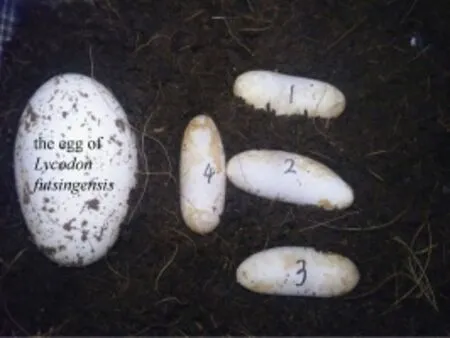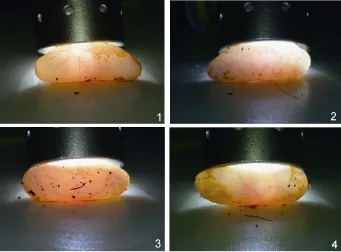New Record of Lycodon liuchengchaoi in Anhui
Liang ZHANG, Li-Fang PENG, Lei YU, Zheng-Ping WANG Li-Qun HUANG, Song HUANG1Guangdong Entomological Institute, Guangzhou 1020, China
2Guangdong Public Laboratory of Wild Animal Conservation and Utilization, Guangzhou 510260, China
3College of Biology and Environment, Graduate School, Nanjing Forestry University, Nanjing 210037, China
4Huangshan University, Huangshan 245041, China
5Anhui Bird Watching Society, Hefei 230601, China
6Bureau of Parks, Huangshan Management Committee, Huangshan Tourism Development Co., Ltd, Huangshan 245000, China
New Record of Lycodon liuchengchaoi in Anhui
Liang ZHANG1,2,†, Li-Fang PENG3,4,†, Lei YU5, Zheng-Ping WANG4, Li-Qun HUANG6, Song HUANG4,*
1Guangdong Entomological Institute, Guangzhou 510260, China
2Guangdong Public Laboratory of Wild Animal Conservation and Utilization, Guangzhou 510260, China
3College of Biology and Environment, Graduate School, Nanjing Forestry University, Nanjing 210037, China
4Huangshan University, Huangshan 245041, China
5Anhui Bird Watching Society, Hefei 230601, China
6Bureau of Parks, Huangshan Management Committee, Huangshan Tourism Development Co., Ltd, Huangshan 245000, China
One juvenile and one adult female wolf snake (Colubridae: Lycodon) were sampled at Yixian and Fuxi, Huangshan, Anhui, China in the summer of 2011 and 2012, respectively. The two specimens were identified as Lycodon liuchengchaoi based on external morphology and molecular data. This is a new reptile record in Anhui Province. In our laboratory, four eggs were laid and three neonates were hatched successfully. This is the first record of the laying and incubation of L. liuchengchaoi eggs. The five specimens were deposited at the Museum of Huangshan University (HUM20140001) and Guangdong Entomological Institute (HB-lcfsp12613, HB-lcfsp-ch1~3).
Reptile; Lycodon liuchengchaoi; Incubation; New record
In our routine summer ecological investigations of amphibians and reptiles in Huangshan of Anhui Province, a juvenile wolf snake (Collection number: HUM20140001, Figure 1) was sampled at Yixian (E117°9.112′, N29°9.248′) on June 24, 2011, and a female adult wolf snake (Collection number: HB-lcfsp12613, Figure 2) was collected at Fuxi (E118°8.191′, N30°5.439′; 700 m a.s.l.) on June 3, 2012. The two specimens were identified as L. liuchengchaoi (Zhang et al, 2011a). This is the first time that L. liuchengchaoi has been found in Anhui, China (Chen et al, 1991; Zhao et al, 1998; Zhao, 2006; Zhang et al, 2011a).

Figure 1 Juvenile Lycodon liuchengchaoi (HUM20140001) sampled at Yixian, Huangshan

Figure 2 Adult female Lycodon liuchengchaoi (HB-lcfsp12613) sampled at Fuxi, Huangshan
EXTERNAL MORPHOLOGY
1
External morphological examination of the two specimens showed elongated and subcylindrical bodies; head distinct from neck, distinctly flattened; snout projected beyond lower jaw; vertebral ridge poorly developed. When different from HS12088, the features of HB-lcfsp12613 follow in parentheses. HS12088 juvenile (adult female) with snout-vent length: 126 mm (316 mm), tail length: 36 mm (104 mm), tail length/total length: 0.222 (0.248); dorsal scale rows 17-17-15; dorsal scales small and feebly keeled in median several rows close with the ridge (invisible on neck); ventrals 190 (228), angulated weakly; anal entire; subcaudals 75.
Rostral large, triangular, about 1.5 times as broad as deep; nasal divided, nostril in the anterior nasal; internasals subtriangular and slightly broader than long; laterally in contact with nasal; loreals rectangular, contacting orbit; pupil elliptical; preocular 1/1, upward; postoculars 2/2; temporals 2+3/2+3; supralabials 8 (2+3+3)/8 (2+3+3), first supralabial in contactwith rostral and nasal, second supralabial in contact with nasal and loreal, third, fourth and fifth entering eye, sixth in contact with postocular and anterior temporal, seventh in contact with lower anterior and lower posterior temporal, eighth in contact with posterior temporal; infralabial 8/8. Prefrontals not in contact with orbit but with loreal; prefrontal suture obviously longer than internasal suture; frontal subtriangular, long and wide slightly equal; parietals longer than broad, parietal suture obviously longer than frontal suture.
Body ground color black; crown largely black, except for a yellow crossband across the occipital, faint or incomplete along the midline; 25 (33) jagged-edged, brownish-yellow rings on the body, and 8 (12) on the tail. The width of all rings are 2 to 3 dorsal scales. The yellow rings extend across the belly as wide as 2 to 4 ventral plates. The above-mentioned data are listed in Table 1 and are compared with those of the type specimen (Zhang et al, 2011a) and Shaanxi specimen (Peng et al, 2014). They agreed in characteristics of scales and colored patches.
Uncorrected P-distance of partial cytochrome b
Total genomic DNA was extracted according to the phenol/ chloroform extraction procedure (Sambrook et al, 1989). One mitochondrial DNA segment (cytochrome b, 832 bp) of the two specimens was obtained by polymerase chain reaction (PCR) and direct sequencing using the primers and methods described in Burbrink et al (2000). The two sequences shared one haplotype (GenBank accession number: KP898899). The uncorrected P-distance was 0.8% between this haplotype and L. liuchengchaoi (GenBank accession number: Kf732928; Lei et al, 2014). Genetically, they were identified as L. liuchengchaoi.
Laying and incubation of eggs
All measurements and observations were conducted on live snakes, and the description of the eggs was taken at 90% humidity.
Wolf snakes are oviparous. The adult female snake (HB-lcfsp12613) laid four eggs (Figure 3) in our laboratory on June 11, 2012. The eggs were white, smooth-shelled and nonadhesive. Egg weight was 0.77-0.84 g (average 0.805 g), long diameter was 24.8-25.0 mm (24.9 mm) and short diameter was 7.0-7.3 mm (7.2 mm). The ratio of long diameter to short diameter was 3.46.

Figure 3 Four eggs from female Lycodon liuchengchaoi (HB-lcfsp12613) (Photo by Liang ZHANG)
The four eggs were incubated in our laboratory at room temperature. The temperature ranged from 24 °C to 35 °C in June and July, 2012, at Guangzhou. The eggs were buried in the substrate at near half the volume. Water was sprayed on the substrate once a day to maintain proper humidity. Figure 4 shows the four incubated eggs on the seventh day. On July 28, three neonate snakes were hatched successfully (Figure 5). The period of incubation lasted 48 days. On August 7, all three neonates sloughed their skin (intact) for the first time. Total length of the three neonates was 134.51-147.64 mm (average 141.65 mm), tail length was 32.44-35.94 mm (34.25 mm), tail length/total length was 0.242, and head length was 6.98-8.19 mm (7.68 mm).

Figure 4 Four eggs on the seventh day of incubation (Photo by Liang ZHANG)
DISCUSSION
Huangshan lies in the southern part of Anhui Province. Seventy-eight percent of this region is forested and the level of snake diversity is highest. Among the 51 snake species found in Anhui, 49 species are found in Huangshan, including the newly discovered species described in this paper. (Chen et al, 1991; Chen et al, 2013; Huang, 1990; Huang et al, 2007; Peng & Huang, 2015; Zhao, 2006).
Lycodon liuchengchaoi was initially described based on three specimens from Tangjiahe and Monping (Hengduan Mountains) in Sichuan in 2011 (Zhang et al, 2011a). Peng et al (2014) found one female adult L. liuchengchaoi from Ningshan (Qinling Mountains) in Shaanxi. The new record sites (Huangshan Mountains, this paper) are nearly 2 000 km from the known distribution localities. There are many suitable habitats available between these sites, and this species might also occur in Henan (Funiushan Mountains) and Hubei (Dabieshan Mountains). As we only compared the cytochrome b fragments between our samples and the reported L. liuchengchaoi, and observed few differences, it might be desirable to collect more specimens of this species and perform phylogenetic analysis of related species within the same genus. It would also be appropriate to use other DNA markers with a high mutation rate to determine intraspecies genetic diversity, and reconstruct the potential migration route.

Figure 5 Neonate emerging from its shell (1-6) (Photo by Liang ZHANG)
In recent years, a growing number of small-sized snakes have been found in the field (Chen et al, 2013; Li et al, 2012; Peng & Huang, 2015; Sun et al, 2013; Wang et al, 2015; Zhang et al, 2011b). One possible reason might be the decline of natural small snake predators. For example, some large-sized snakes, which naturally feed on small snakes, have been overhunted in recent years, e.g., Elaphe carinata, Ptyas dhumnades, Orthriophis taeniurus, Naja atra and Bungarus multicinctus.
ACKNOWLEDGMENTS
We thank Dr. Hui-Jian HU (Guangdong Entomological Institute), Yong ZHANG, Yu-Sheng SU and Su-Ping ZOU (Huangshan University) for their help with counting scales.
Burbrink FT, Lawson R, Slowinski JB. 2000. Mitochondrial DNA phylogeography of the polytypic North American rat snake (Elaphe obsoleta): a critique of the subspecies concept. Evolution, 54(6): 2107-2118.
Chen BH, Sun YL, Liang RJ, Wang YQ, Li BH, Dong YW, Wang AT, Yuan XB. 1991. The amphibian and reptilian fauna of Anhui. Hefei, China: Anhui Sciences and Technology Publishing House, 235-361. (in Chinese)
Chen JM, Tang XS, Huang S. 2013. Sinomicrurus kelloggi firstly found in Anhui province, China. Chinese Journal of Zoology, 48(1): 134-135. (in Chinese)
Huang JT. 1990. Azemiops feae: A new record of snake from Anhui Province, China. Sichuan Journal of Zoology, 9(2): 30. (in Chinese)
Huang S, He SP, Peng ZG, Zhao K, Zhao EM. 2007. Molecular phylogeography of endangered sharp-snouted pitviper (Deinagkistrodon acutus; Reptilia, Viperidae) in Mainland China. Molecular Phylogenetics and Evolution, 44(3): 942-952.
Lei J, Sun XY, Jiang K, Vogel G, Booth DT, Ding L. 2014. Multilocus phylogeny of Lycodon and the taxonomic revision of Oligodon multizonatum. Asian Herpetological Research, 5(1): 26-37.
Li ZY, Luo J, Wei QL, Yu BC, Zhang L. 2012. Lycodon fasciatus: A snake new record to Guangdong Province, China. Chinese Journal of Zoology, 47(1): 116-118. (in Chinese)
Peng LF, Huang S. 2015. Achalinus rufescens was found in Anhui Province, China. Chinese Journal of Zoology, 50(1): 159. (in Chinese)
Peng LF, Zhu YW, Huang S. 2014. Lycodon liuchengchaoi was found in Shaanxi Province, China. Chinese Journal of Zoology, 49(6): 952. (in Chinese)
Sambrook J, Fritsch EF, Maniatis T. 1989. Molecular Cloning: A Laboratory Manual. 2nd ed. New York: Cold Spring Harbor Laboratory Press.
Sun XY, Lei J, Ding L. 2013. Sibynophis chinensis firstly found in Hebei Province, China. Chinese Journal of Zoology, 48(1): 139-140. (in Chinese)
Wang DQ, Yang DC, Peng LF, Cheng ZW, Xu JC, Hu XQ, Huang S. 2015. Sinomicrurus kelloggi was Found in Yunnan Province, China. Sichuan Journal of Zoology, 34(2): 314. (in Chinese)
Zhang J, Jiang K, Vogel G, Rao DQ. 2011a. A new species of the genus Lycodon (Squamata, Colubridae) from Sichuan Province, China. Zootaxa, 2982: 59-68.
Zhang L, Jiang K, Hu P, Yu BC, Peng BY, Tang XP, Hu HJ. 2011b. Lycodon futsingensis: a new snake record in Guangdong Province, China. Chinese Journal of Zoology, 46(1): 128-130. (in Chinese)
Zhao EM. 2006. Snakes of China. Hefei, China: Anhui Sciences and Technology Publishing House, 215-219. (in Chinese)
Zhao EM, Huang MH, Zong Y. 1998. Fauna Sinica: Reptilia, Vol. 3. Squamata, Serpentes. Beijing: Science Press, 570 pp. (in Chinese)
Received: 12 March 2015; Accepted: 24 April 2015
Foundation items: This project was funded by the National Natural Science Foundation of China (NSFC 31071891, 31471968)
*Corresponding author, E-mail: snakeman@hsu.edu.cn
† Authors contributed equally to this work
- Zoological Research的其它文章
- A reflection on the significant findings published in Zoological Research over the past 35 years
- New observations - with older ones reviewed - on mass migrations in millipedes based on a recent outbreak on Hachijojima (Izu Islands) of the polydesmid diplopod (Chamberlinius hualienensis, Wang 1956): Nothing appears to make much sense
- Molecular characterization of an IL-1β gene from the large yellow croaker (Larimichthys crocea) and its effect on fish defense against Vibrio alginolyticus infection
- Selective recruitment of host factors by HSV-1 replication centers
- Social organization of Shortridge’s capped langur (Trachypithecus shortridgei) at the Dulongjiang Valley in Yunnan, China
- Establishment of HIV-1 model cell line GHOST(3) with stable DRiP78 and NHERF1 knockdown

